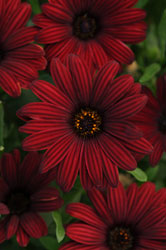1/31/2015
Real Series: Serenity Osteospermum
Ryan Hall

The classic daisy blooms of osteospermum have come a long way since their humble beginnings massed along California freeways in seas of purple and white. This durable landscape plant from South Africa was right at home on the West Coast and quickly received the uninspiring name of “Freeway Daisy” due to its resiliency. Fast forward more than a decade and long gone are the rangy plants with narrow color options. Osteospermum have become one of the kings of early-season color. Tamed by breeders, there are now colors only limited by the imagination—from traditional purple and white to attractive bronze, yellow and red.
Pictured: Serenity’s broad range of colors includes the fantastic new Serenity Red.
Below: Osteo have come a long way since their early days as a coastal landscape plant.
Since osteospermum thrive in cool conditions, they can be grown with limited to no additional heating. On the West Coast and most frost-free areas, osteospermum can be grown in an unprotected field or in a high tunnel environment if one wants to keep the rain off and have total control over moisture management. In the North, growers can finish plants in cool greenhouses and reserve warm temperatures for more heat-intensive crops. Along with breakthrough colors, breeders have also developed very grower-friendly habits, making osteo not only energy efficient, but also space efficient. Compact genetics in osteo can be grown pot tight or close to it for most of the production cycle.
Serenity Osteospermum from Ball FloraPlant is one of the best series for growers looking for the whole package. There are 14 fantastic colors all paired with compact, well-branched habits, ideal for 1-qt. and 2.5-qt. containers. Serenity Osteospermums are part of Ball FloraPlant’s Real Series group of plants, which gives growers confidence in a series matched in vigor, habit and flower timing. This allows growers to deliver the full range of colors to market all in the same week.
An additional advantage of Serenity is the option of using Genesis callused cuttings. Genesis cuttings minimize bench times and reduce input costs because they can be direct stuck into smaller containers, such as 4.5 in. and 1 qt., shaving weeks off a traditional crop time.
Production of osteospermum is very straightforward, but growers must pay attention to the appropriate crop times and temperatures to produce the highest quality plants. Here are some tips to maximize the potential of Serenity Osteospermum.
Crop time: Rooted liner to finish
Osteospermum are moderately slow growers and appreciate enough crop time to grow to their full potential. Growers should avoid trying to push osteos with higher temperatures and shorter crop times. This will typically result in poor habits and reduced flower count.
 Transplanting & media
Transplanting & media
The key at transplanting is starting with a well-branched toned liner. Avoid planting stretched liners. If liner plants are stretched, growers should do a moderate pinch down to a few nodes at the time of transplant or shortly thereafter. Osteospermum require a well-drained medium. Most modern soilless medias work well, regardless of the components, as long as the drainage and porosity is adequate. Soil pH should trend on the moderately acid side, with a pH of 5.8 to 6.2 being ideal.
Temperatures
As mentioned, osteospermum thrive under cool conditions. After transplanting, allow plants to become established for 1 to 2 weeks at 60 to 65F (15 to 18C). Once liners have rooted in, temperatures can be dropped to 59 to 76F (15 to 24C) days and 44 to 55F (6 to 12C) nights for the remainder of the crop time. This combination of cool temperatures and long crop time will give you the best overall habit and flower count.
Light levels & photoperiod
Osteospermum should be grown under high-light conditions with foot candles ranging from 5,000 to 8,000 fc. Osteospermum will bloom from early spring through to fall in cool areas of the country, such as coastal California. Excessively warm temperatures will adversely affect flowering, so it’s best for growers in warmer parts of the country to position osteospermum as part of their early-spring and spring assortments. Combining cool temperatures with a high DLI will produce the best overall quality plant and maximize flowering.
Fertilizer & pH
Osteospermum are heavy feeders and should receive between 225 to 300 ppm N. Nitrate-based fertilizers are best used to minimize soft vegetative growth that will adversely affect the overall finished quality of the plant. It’s best to avoid ammonium-based fertilizers, especially when paired with lower light conditions and warm temperatures. This will encourage soft and leggy growth.
PGRs
Serenity is naturally compact and needs little to no growth regulators, especially when grown in high light with cool temperatures. If additional control is required, a tank mix of B-Nine/Cycocel (s) 1,500 B-Nine/750 Cycocel is effective in controlling excessive growth.
Pests & disease
Common pests for osteospermum are aphids, whitefly and thrips. Proper sanitation, scouting and preventative rotations should help reduce pressure from pests. Common diseases include root and stem rots, as well as Botrytis. Provide adequate air circulation and avoid wet foliage during the night to minimize disease pressure.
GT
Ryan Hall is a Product Manager for Ball FloraPlant.